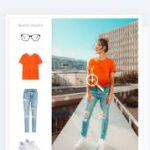In the ever-evolving world of digital search and marketing. One trend is quickly reshaping the landscape: visual search optimization. As artificial intelligence (AI), machine learning, and mobile technology converge, traditional keyword-based search is now being complemented. In some cases, it is replaced by camera-based search. Visual search lowers friction and produces more intuitive user experiences by enabling people to find what they need by only snapping a picture or uploading an image.
Now that platforms like Google Lens, Pinterest Lens and Snapchat Scan are getting so much traction, businesses cannot ignore it anymore. Optimizing content for visual search technology has become essential. It is needed to stay competitive in search engine rankings and meet users’ expectations for seamless, visually driven discovery.
In this article, we will explore the evolution of visual search. Why does it matter in today’s digital environment? How can you practically optimize your website? And content for this exciting new frontier.
What Is Visual Search and How Does It Work?
Instead of typing text, users can now perform searches using images thanks to visual search technology. Rather than typing in search terms such as leather brown boots with heel, a user can take a picture of a pair of shoes and get presented with shoes like it or visually similar and available for purchase.
Tools such as Google Lens use AI-powered search and image recognition SEO algorithms to evaluate uploaded images. To produce results that are consistent with the context and content of the object, these tools scan visual elements like shapes, colors, logos, patterns, and text.
This method of search is highly effective for shoppers. Especially in industries like fashion, home decor, automotive, and food. Where users often find it easier to show rather than describe what they are looking for. It is also transforming how people interact with products in the real world. This leads to increased demand for retail visual search capabilities.
Why Visual Search Optimization Matters
According to the latest market research, over 60% of Gen Z and Millennial consumers prefer camera-based search over submitting queries. Users now demand quick, precise, and customized visual discovery because there are billions of photos on sites like Instagram, Pinterest, and TikTok.
For brands and marketers, visual search marketing is not just a hype word, it is a powerful tool to enhance visibility and drive conversions. Those who adapt early see results:
- Higher engagement rates through image-rich content
- Improved discoverability on visual platforms like Pinterest and Google Images
- Increased sales from users using visual search tools to find products instantly.
In case you are in the e-commerce world, e-commerce visual search can minimize the steps between the generation of interest to purchase. Customers are more likely to convert if they can use the camera on their phone to find products that are like what they have seen online or in person, especially if visual AI shopping tools are available.
Key Strategies to Optimize for Camera-Based Queries
1. Use High-Quality, Contextual Images
Visual search is only as good as the content it can analyze. Use clear, illuminated, high resolution images that present your product from different viewpoints. Backgrounds should be simple, and objects should be recognizable. This improves object recognition of product discovery where AI tools can give meaning to what is in your picture.
Also, show your product in real-life settings where possible. This creates stronger visual content optimization which helps the search engines to connect the product with lifestyle usage and customer’s purpose.
2. Write Descriptive ALT Text and File Names
Detailed ALT text is a foundation of image recognition SEO. It not only makes it easier for screen readers to access it but also makes it easier for visual search engines to index it. For instance, use tan-leather-crossbody-bag-women.jpg rather than product1.jpg.
In the ALT tag, provide keyword rich, exact portrayals, such as:
<img src=”tan-leather-crossbody-bag.jpg” alt=”Women’s tan leather crossbody bag with adjustable strap and gold buckle”>
This helps enhance your content for both traditional and visual search engine algorithms.
3. Implement Schema Markup for Images

Search engines can understand exactly what your visual content represents thanks to structured data provided by adding schema markup for images. Product, Image Object, and Offer schema tags, for instance, can be used to improve product listings and qualify them for improved search functions, such as Google’s visual snippets.
Schema also allows your content to surface in Google Lens SEO results more effectively. Ensuring your images are machine-readable and properly indexed.
4. Optimize for Mobile Users
Since most camera-based search happens through mobiles phones, mobile optimized experience is necessary. Ensure your website is responsive, fast-loading, and has touch-friendly design elements. The more seamless your user experience is, the more likely you are to keep a user who started a trend of using their phone to search for images.
Google’s Core Web Vitals metrics loading, interactivity, and visual stability. It should be closely monitored for image-heavy pages.
5. Use Pinterest and social media for Visual Indexing
Platforms like Pinterest function as powerful visual discovery tools. You can generate long-tail traffic to your site by posting high-quality optimized pins using keywords. To assist users in finding and purchasing your products straight from visual platforms, use Pinterest Lens marketing strategies like adding rich pin data and linking to shoppable landing pages.
This will enable you to go beyond the web and into social places where your target audience can be found.
Industry Use Cases and Future Trends
Visual search is being rapidly adopted across multiple sectors:
- Fashion: Users take a photo of an outfit they like and instantly find similar items available for purchase.
- Furniture: Customers upload an image of a décor item and discover lookalike pieces from online catalogs.
- Food & Grocery: Apps scan meals to find recipes or add ingredients to a grocery list.
- Travel: Snap a picture of a landmark and get instant tourist info, history, or booking options.
Anticipate additional integration with voice search, augmented reality (AR), and real-time visual assistance tools as camera search trends develop. The future lies in fully immersive and intuitive interfaces. Where customers can explore, interact and purchase all from a single snapshot.
Conclusion: Prepare Now for a Visual Future
Visual search optimization is no longer an optional feature. It is a necessity for forward thinking digital strategies. As users become more visually driven and mobile first. Your content must be primed for AI-powered search technologies that rely on images rather than just words.
Achieving this by targeting image recognition SEO, utilizing visual discovery tools, and ensuring your media is optimized with intelligent metadata and schema markup for images will also make your site easier to find and competitive within this new camera-based search.
Whether you are a marketer, developer, or business owner. The time to embrace visual search is now. Those who adapt today will lead tomorrow’s search results.
